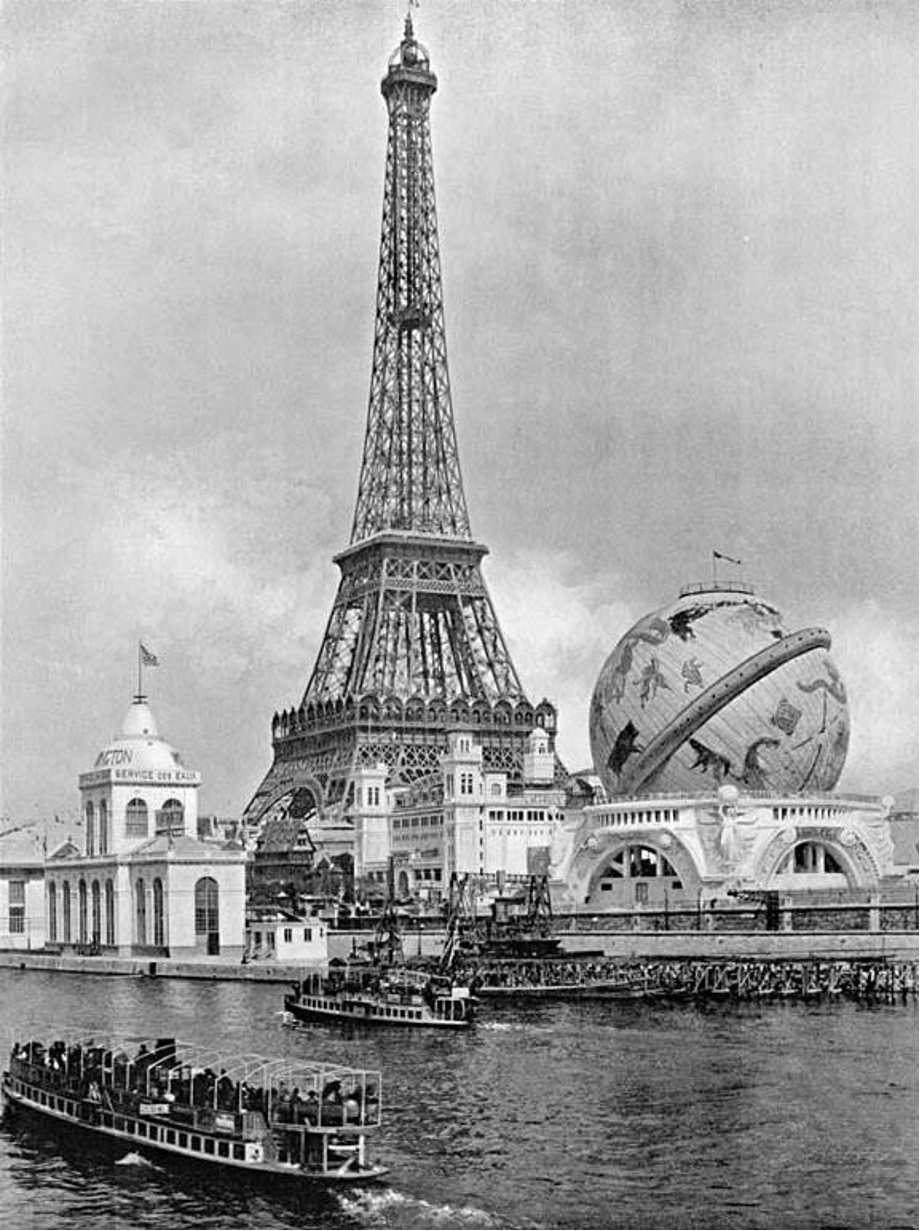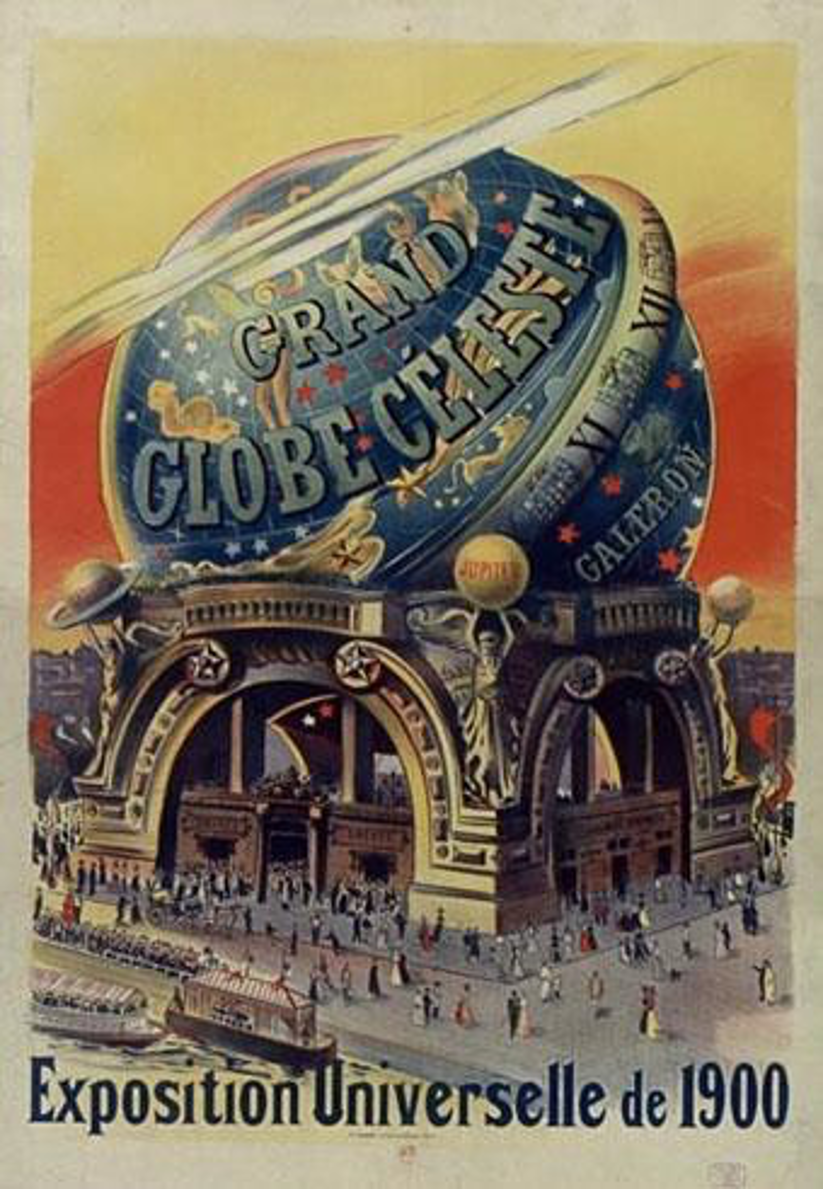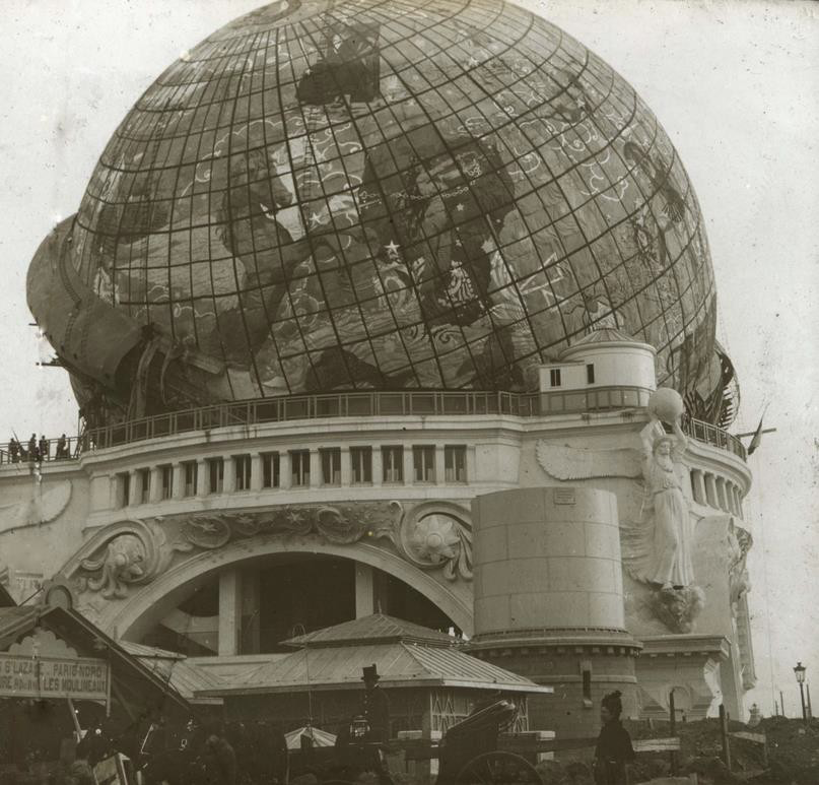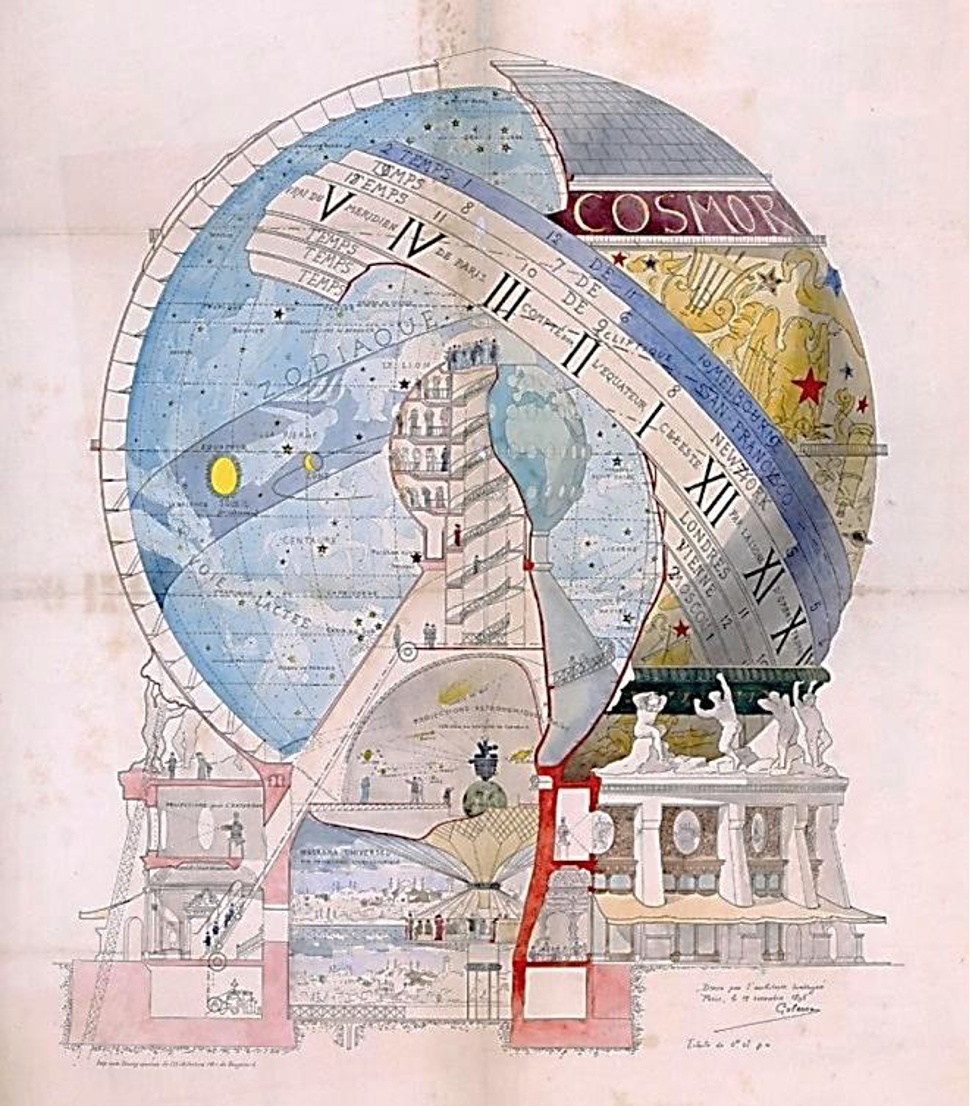This Month in Astronomical History: April 2024
Kenneth Rumstay Valdosta State University (Emeritus)
 Each month as part of this series from the AAS Historical Astronomy Division (HAD), an important discovery or memorable event in the history of astronomy will be highlighted. This month, Ken Rumstay writes about the astronomical exhibits at the Great Paris Exposition of 1900. Interested in writing a short (500-word) column? Instructions along with previous history columns are available on the HAD web page.
Each month as part of this series from the AAS Historical Astronomy Division (HAD), an important discovery or memorable event in the history of astronomy will be highlighted. This month, Ken Rumstay writes about the astronomical exhibits at the Great Paris Exposition of 1900. Interested in writing a short (500-word) column? Instructions along with previous history columns are available on the HAD web page.
The Great Paris Exposition of 1900
Part One: Le Grand Globe Céleste
Although the concept of a world’s fair can be traced back to 1791, when an industrial exposition was organized in Prague to mark the coronation of King Leopold II of Bohemia, the Great Exhibition of 1851 in London (formally The Great Exhibition of the Works of Industry of All Nations) is generally considered to be the first modern World’s Fair.1 Open to the public between 1 May and 15 October, it was also known as the Crystal Palace Exhibition, in reference to the enormous (1848 by 454 feet; 563 by 138 meters) temporary structure in which it was held.
In a 2004 article, Tjaco Walvis noted that the character of international expositions evolved in the following years.2 He suggested that they fall into three distinct categories: The Era of Industrialization (1851–1938), the Era of Cultural Exchange (1939–1987), and the Era of Nation Branding (1988–Present). The first international expositions were largely focused on trade between nations and served as platforms for each country’s scientific and technological advancements. From the beginning scientific instruments, especially large ones, were given places of honor (Figure 1).
A feature common to these expositions was an imposing central structure, constructed by the hosting nation, which frequently served as an identifying icon. These included the Crystal Palace (London, 1851), the Palais de l'Industrie (Paris, 1855), and the Rotunde (Vienna, 1873). Constructed for the Exposition Universelle of 1889, the Eiffel Tower (though widely despised at first) has served as the symbol of Paris for well over a century; it is perhaps the most recognizable structure ever created. As the United States prepared to celebrate the 400th anniversary of Columbus’ arrival in the New World, planners of the 1893 World's Columbian Exposition in Chicago searched for a symbol to rival Gustave Eiffel’s achievement. The result was the 80-meter diameter Chicago Wheel, the world’s first Ferris wheel.
Seven years later, it was Paris’ turn to host a world’s fair again. The Exposition Universelle of 1900 opened on 14 April of that year and, by the time it closed on 12 November, hosted over 48 million visitors.3 It boasted the Grande Roue de Paris, essentially copied from Ferris’ design but 15 meters taller. And, dominating the skyline next to the Eiffel Tower, stood Le Grand Globe Céleste: an enormous celestial sphere 45 meters in diameter on which were painted the constellations and signs of the zodiac (Figures 2 and 3). The sphere rested on a base, about 18 meters in height, composed of four masonry pillars containing staircases and elevators (Figure 4). Designed by Napoleon de Tédesco, this unique structure featured a restaurant, a garden, and a vast interior exhibition space in the form of a planetarium. Within, spectators seated in comfortable armchairs watched a presentation on the stars and planets projected overhead.
In his book L'exposition universelle de 1900,4 Louis Rousselet described his impressions in the following way:
Upon leaving the Palace of Optics, we see an immense sphere silhouetted against the horizon, all covered with brightly colored paintings. It is the Great Celestial Globe, which in some way completes the astronomical teaching of the Palace of Optics.
If, approaching the immense globe, one is struck by its dimensions and surprised to see that the entire sphere appears to be supported in the air on its formidable base, penetrating into the interior, the astonishment becomes even greater. One is surprised and charmed at the same time by the original layout, the curious construction of this monument.
The Great Celestial Globe is divided into three floors, served by stairs and elevators. On the first floor, where we see the base of the gigantic ball, the view rests pleasantly on flowers and plants. On the floor above we are inside the globe, where a large café-restaurant is located. From there we arrive in the celestial sphere, in the middle of the Heavens represented – save for the southern regions invisible from Paris - in their entirety, with all the luminous stars appearing to be located at infinite depths. At the center of this infinity, here is the Earth slowly rotating on its axis. It seems as if we are floating in the ethereal regions and that we are witnessing the true revolution of the worlds.
Two staircases lead into the Earth. At the equator, looking through one of the portholes placed on the surface, we see half of the sky with the stars rising and setting at the same time on our horizon. Higher up, here is the latitude of Paris with eight windows and the sky observable from this point. Finally, we arrive at the North Pole, at midnight; all the stars are circumpolar in their apparent diurnal movement. We also follow the various phases of the moon in its movement around the earth.
[Translation by the author5]
The cutaway drawing by Albert Galeron (Figure 5) vividly depicts what visitors to this marvelous attraction would have experienced. A ticket to this virtual voyage through the heavens cost 1.5 francs (roughly equivalent to $10 or $20) today, and spectators enjoyed a musical accompaniment (an organ had been installed inside the attraction) composed especially for the occasion by Camille Saint-Sains.6
Tragically, barely two weeks after the exhibition’s inauguration by French President Émile Loubet, Le Grand Globe Céleste became the scene of a fatal accident. On 29 April one of the access ramps collapsed onto the street below, killing nine persons (Figure 6). Investigation revealed that the ramp had been hastily constructed of reinforced concrete, a relatively new technique introduced less than 50 years earlier.7 The accident resulted in an official inquiry by French authorities and led the formation of the Committee on Reinforced Cement by ministerial decree on 19 December 1900. A later judicial proceeding held the City of Paris responsible, condemning it for carrying out excavations too close to the structure which led to its collapse.
What did Louis Rousselet mean when he said that “the Great Celestial Globe … completes the astronomical teaching of the Palace of Optics?” That’s a story for next month.

Fig. 1: The “Trophy Telescope" exhibited at the Great Exhibition of 1851. With its 11-inch lens (manufactured by Ross of London) and German equatorial mounting (fashioned by Ransome & May of Ipswich), it was considered the Trophy of the Crystal Palace Exhibition.8

Fig. 2: The Grande Globe Céleste was located beside the Eiffel Tower, constructed just eleven years earlier for the Paris Exposition of 1889. (This image is credited to Neurdein Frères, of the Parisian publishing house Neurdein et Cie.9)

Fig. 3: Poster advertising the Exposition Universelle, featuring the Grande Globe Céleste.10

Fig. 4: The base of the Grande Globe Céleste.

Fig. 5: Cutaway drawing of the Grande Globe Céleste, by the French architect Albert Galeron. This drawing was reproduced in the May 2020 issue of The Architectural Review.12

Fig. 6: Drawing of the pedestrian walkway which collapsed on 29 April, killing nine.6
Notes and References
- Rudolph, Richard F. (1975). "The Pattern of Austrian Industrial Growth from the Eighteenth to the Early Twentieth Century", Austrian History Yearbook. Cambridge University Press. 11: 3–25. doi:10.1017/S0067237800015216. S2CID 145393467.
- Walvis, Tjaco, ed. (April 2004). "Three eras of World Expositions: 1851–present". Cosmopolite: Stardust World Expo & National Branding Newsletter. Amsterdam: Stardust New Ventures (5): 1.
- https://en.wikipedia.org/wiki/Exposition_Universelle_(1900)
- Rousselet, Louis (1901). L'exposition universelle de 1900. Paris: Librairie Hachette, p.286.
- The original French text:
En sortant du palais de l’Optique on voit se découper sur l’horizon une immense sphère toute bariolée de peintures de couleurs vives. C’est le Grande Globe Céleste qui complète en quelque sorte l’enseignement astronomique du palais de l’Optique.
Si, en approchant de l’immense globe, on est frappé de ses dimensions et surprise de voir que la sphere totale semble supportée dans les airs sur son formidable soubassement, en penetrant dans l’intérieur, la surprise deviant encore plus grande. On est étonné et charmé à la fois par la disposition originale, la construction curieuse de ce monument.Le Grand Globe Céleste se divise en trois étages, disservis par des escaliers et des ascenseurs. Au premier étage, où l’on voit la base de la gigantesque boule, la vue se repose agréablement sur des fleurs et des plantes. A l’étage au-dessus, on est dans le globe: un grand café-restaurant y est installé. De là on arrive dans la sphère celeste, au milieu du Ciel représenté — moins la partie australe invisible de Paris — dans son entire, avec tous ses astres lumineux paraissant situés à des profondeurs infinies. Au center de cet infini, voici la Terre tournant lentement sur son axe. Il semble qu’on flotte dans les regions éthérées et qu’on assiste à la véritable révolution des mondes.
Deux escaliers conduisent dans la Terre. A l’équateur, en regardant par l’un des hublots disposés à la surface, on voit une moitié du ciel don’t les astres se lèvent et se couchant dans le mème temps à notre horizon. Plus haut, voici la latitude de Paris avec huit fenètres et le ciel observable de ce point. Enfin on arrive au pòle Nord, au soliel de minuit; tous les astres sont circompolaires dans leur movement diurne apparent. On suit aussi les diverses phases de la lune dans son mouvement autour de la terre. - https://lesyeuxdargus.wordpress.com/2015/04/03/le-globe-celeste-de-lexp…
- https://en.wikipedia.org/wiki/Reinforced_concrete
- Smyth, C. P. (1862). "Trophy Telescope at Wester Elchies", Monthly Notices of the Royal Astronomical Society 23: 1.
- https://www.doaks.org/research/library-archives/dumbarton-oaks-archives…
- https://gallica.bnf.fr/ark:/12148/btv1b9016679w.r=exposition+universell…
- https://www.worldfairs.info/expopavillondetails.php?expo_id=8&pavillon_…
- https://www.architectural-review.com/essays/folio/folio-albert-galerons…;

